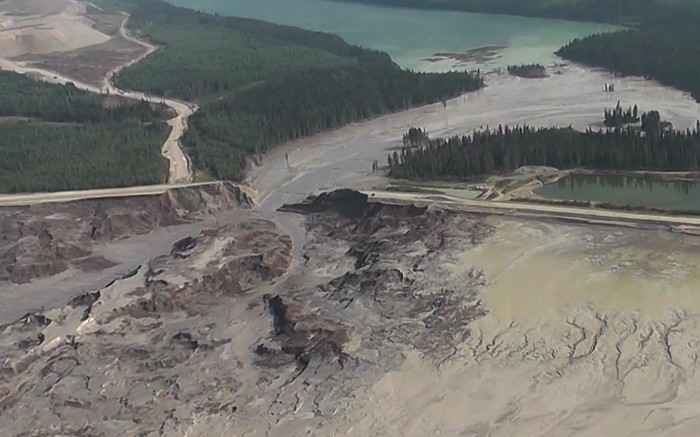The complete failure of the tailings dam at Imperial Metals’ Mount Polley copper–gold mine in Central B.C.’s Cariboo region on Aug. 4 is the most depressing thing to have happened in Canadian mining since the Bre-X Minerals debacle in 1997. It’s the worst tailings dam failure tied to a Canadian company since the Los Frailes disaster in Spain in 1998 (5 million cubic metres spilled) and the Omai spill in Guyana in 1995 (2.3 million cubic metres spilled).
It’s about as big a tailings dam failure as you can get: some 15 million cubic metres of tailings muck has so far flowed out of the mine’s tailings-impoundment area through a gaping hole in an obliterated eastern portion of a huge dam wall.
To see the jaw-dropping scale of the devastation, watch the full video of a helicopter survey of the affected area at http://youtu.be/M1YgX2jXnpA, posted by the Cariboo Regional District authority. The video takes 37 minutes, because the affected area is so huge: the massive tailings facility itself, Polley Lake immediately to the east and the deeply messed-up Hazeltine Creek, which empties into the western reaches of the formerly pristine Quesnel Lake, where there are critical salmon-spawning grounds.
In the video, huge amounts of material is actively flowing out of the tailings facility in great, muddy torrents into Hazeltine Creek. Have you ever seen a waterfall of mine tailings? It’s here in this video, in the middle of Hazeltine Creek — a formerly 1-metre wide trickle of wending water that is now a scoured-out 45 metres wide.
The trees that were ripped out from either side of the creek, along with many tonnes of tailings, have been dumped at the creek’s mouth into Quesnel Lake. The whole tailings area looks abandoned in the video, with the only people visible being a few stunned civilians in boats or on the shores of Quesnel Lake.
Quesnel Lake flows to the northwest into the Quesnel River, which continues westward to the town of Quesnel, where it empties into the mighty Fraser River, 80 km northwest of the Mount Polley mine.
Mount Polley had been on track to produce 47,000 oz. gold, 44 million lb. copper and 120,000 oz. silver this year, but is now closed, and will likely remain so for at least the rest of the year. The mine cannot reopen until the current tailings facility is completely rebuilt or a new one is created next door. Considering that the mine was already running out of space to put its tailings, and there are no obvious quick fixes, the mine will not reopen anytime soon. The mine was slated to close in 2016, but Imperial had been working this year to extend the mine’s life to 2023 by going underground.
A more pertinent question is whether Imperial will even survive this setback in its current corporate form, as it gets caught in a three-way crunch: disaster costs at Mount Polley rising into the hundreds of millions; a loss of cash flow from Mount Polley; and the continuing cash drain of completing the construction of its wholly owned Red Chris copper–gold mine in northwest B.C.
But what makes all this particularly depressing is that Imperial Metals is one of the class acts of Canadian mining, and the mine was built by highly skilled Canadian miners to modern technical standards in our own backyard. And the tailings were flowing uncontrolled through the breach on a beautiful sunny summer day, not after some catastrophic tsunami or once-a-century storm or flood.
And all that Imperial — representing the very best in Canadian mining — could come up was this on the day of the disaster: “The cause of the breach is unknown at this time. The dam . . . operated within design limits and specifications. Monitoring instruments and on-site personnel had no indication of an impending breach.”
In other words, “We ain’t got a clue, folks.”
The meeting the next day between Imperial president Brian Kynoch and affected residents in Likely, B.C., had its moment of dark comedy, too, when a feckless Kynoch told worried residents that of course he would drink the water from the tailings facility, “once the solids come out.” It’s about as meaningful as saying that of course you’d play Russian roulette — once the bullets are taken out of the gun.





Mt. Polley WAS discharging… to Hazeltine Creek.. exactly where the dam burst. No mention of that in the press releases. There WAS notice of the dam failure in a previous smaller incident that Imperial Metals is denying. This inside information is being shared by those involved who questioned the operation. Yet permits stood and tailings built up. And now what? Now that the damage is done? The poisons, reagents, and acid forming minerals are loose in the watershed. All hell has broken loose.
This is a very state-ful piece. It is of-course a very unfortunate incident with very long term implications. BC is a special place and should be supported as such in every resource access and management space.
The irony of the water build-up / lack of permission to discharge / and resulting evidence of this type of planning/management and relationship with local land and resource holders .. is that some discharge or means to do so obviously is necessary.
WATER is a mean (sometimes) resource that you curse as often as bless. At Huckleberry in 2010 we saw too what unusual and inordinate amounts of water — how that could affect normal day to day operations and the best planning of years past and into the future — staff there utilized the instrumentation on hand and correlated historical practice with current “high-tech” interferometry data … solved the riddle, re-planned the mine plan matrix, took all necessary steps to ensure staff, equipment, and most importantly the PIT asset.
Since, there are many examples of leading firms using pore water pressure or depressurization practices and monitoring ALLIED with GB InSAR data to exhibit the potential volume of area affected (swelling / or actual displacement) visible in the datasets — focusing on the same ares in action (depressurization/dewatering) …and having an advantageous result.
Across BC and Canada .. operations cannot fear incidents like this .. what we DO is to embrace the need to not let it happen (unawares) again .. and get to work correcting, mitigating, and managing the natural resources where we are responsible and charged to do so.
The squeeze between profits and expenses seems to always short-cut environment. As long as companies have a say in environmental law and “Industry creep” affects the very agencies charged with watching over them, there will be accidents like this.
Get industry out of government, government should do what it is called to do, represent the interests of the Canadian people.
What investors learn from this incident is to stay away from mining companies that have such exposure.
If you want unlimited risk and uncertain returns, then this type of investment may be for you.
The ‘shock and awe’ value of this mining disaster is quickly running it’s course. The major impact of dam failures, the flow of tailings, has already stopped, no lives were lost, no communities were wiped out, no buildings were destroyed, impact on water quality near communities and down river is about to be demonstrated to be virtually zero and longer term impacts like re-mobilization of heavy metals from the already solidifying tailings and poisoning of spawning salmon will be demonstrated to be weak to non-existent. The Mines Minister has had his say, the local communities have had their say, re-criminations from former employees have been heard and the company’s record has been dissected for evidence of greed overcoming good sense. This only leaves the floating islands of debris threatening docks and potentially a bridge to keep the story alive and that is being dealt with already. While the Northern Miner is obliged to comment on what has happened it surprises me that this publication is not leading the charge to get the facts out there. So far this has been left to Mr Kynoch as the only voice in the wilderness of media hype and obfuscation.
This is what happens when bean counters with no personal experience get control of a company finances and where and when to spend the money bad choices are made with no penalties to those responsible this is happening in all our major industries the on site supervision have to get permission from head office by then its usually to late Clint Martindale
Page 103 of the feasibility study August 2004 (collected from http://www.sedar.com ) : A foundation drain and pressure relief well system located downstream of the Main Embankment prevents the build up of pore pressure in the foundation and collects seepage from the base of the Tailings Storage Facility.
My private opinion after the look through the site video and the speed of the dam collapse is as following: I suspect that pore pressure increased in the bottom part of the dam due to the blockage of the foundation drain system. The fault can be due to the bad design at the beginning (in this situation firm X will be responsible) or due to the redesign of the dam later (so firm Y will be at fault) or due to the usage of low quality material for drains or damage to these drains during the construction or due to the ice !!! It is probable that in the last winter with heavy snow in this region some melting and freezing blocked totally the drains and damaged them (ruptured!) so later they collapsed.
As a result in all similar dams all similar drains should be looked through with the small cameras (pigging!!!). If not we can similar cases soon …
The other parts of this same dam should be checked for drainage situation as quickly as is possible with cameras and other equipment. It may give some answers to the main question: who should pay the bill ? The owner of the dam or the consultants who design this nice edifice …
The F.N. have served an eviction notice to Imperial metals of Mount Polley Mine.
Premier Christy Clark has a recall out on her. PM Harper is mostly to blame. He caters to big business and has deregulated safety standards. Deregulated environment safety standards and has stripped Environment Ministry of funds. Resource projects are permitted to operate with, acute shortages of staff. So, now the greed has caught up. Although we know, just who will have to pay for this disaster. The tax payers will be stuck with a mess, that wasn’t their fault.